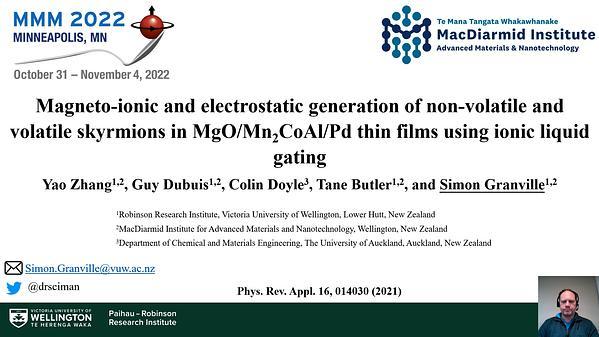Would you like to see your presentation here, made available to a global audience of researchers?
Add your own presentation or have us affordably record your next conference.
Recently, much effort has been directed towards increasing the areal density of Heat-Assisted Magnetic Recording (HAMR) 1-2. Here, we use our HAMR recording simulation 3 that employs renormalized media parameters to examine the potential use of a pulsed laser instead of a continuous laser. By carefully tuning parameters such as peak temperature, decay rate and inter-granular exchange, the pulsed laser is shown to have better recording performance. It also produces less average heat in the media and thus improves near field transducer lifetime. We employ the thermal profile of the discontinuous laser described in our previous work 4. Optimization yields a peak temperature of around 950K and a time constant for heat dissipation of about 0.5 nS. This is fortunate because 0.5 nS also appears to be the experimental value of time constant for at least some media stacks. Inter-granular exchange of 10% is found to be optimal for both the continuous and pulsed laser configurations. Our results show that the optimized pulsed laser reduces Adjacent Track Erasure (ATE) relative to the continuous laser. For example, Fig. 1 shows that the pulsed laser system shows a lower decay rate with write number than the continuous laser. This could be understood from Fig. 2, where the averaged thermal activation is calculated. Here, the pulsed laser has a narrower distribution along the cross-track direction, which means the signals written on track 1 are less affected by the signals written on the adjacent track. We believe that the effectiveness of our pulsed laser approach relies on properly synchronizing the pulse with the magnetic field change: 0.1 nS delay works best. This allows the gradient at the edge of the writing bubble to almost double when transitions are initiated.
References:
1 McDaniel, Terry W. Journal of Physics: Condensed Matter 17.7 (2005): R315.
2 Weller, Dieter, et al. IEEE transactions on magnetics 50.1 (2013): 1-8.
3 Victora, R. H., and Pin-Wei Huang, IEEE Transactions on Magnetics 49.2 (2013): 751-757.
4 Natekar, Niranjan A., and R. H. Victora, IEEE Transactions on Magnetics 57.3 (2020): 1-11.
 Fig1. SNR variation of pulsed laser and continuous laser for different IGC for ECC media. Write Number is the number of times the adjacent track is overwritten. ECC media is made up of 3nm superparamagnetic writing layer and 6nm FePt storage layer. Bit length is 20 nm and velocity is 20 m/sec.
Fig1. SNR variation of pulsed laser and continuous laser for different IGC for ECC media. Write Number is the number of times the adjacent track is overwritten. ECC media is made up of 3nm superparamagnetic writing layer and 6nm FePt storage layer. Bit length is 20 nm and velocity is 20 m/sec.
 Fig2. Averaged thermal activation of pulsed laser and continuous laser along cross-track direction.
Fig2. Averaged thermal activation of pulsed laser and continuous laser along cross-track direction.
